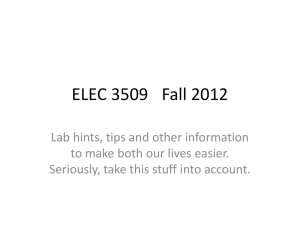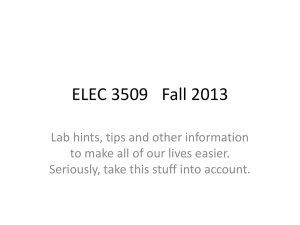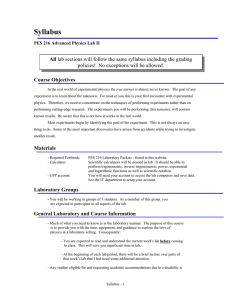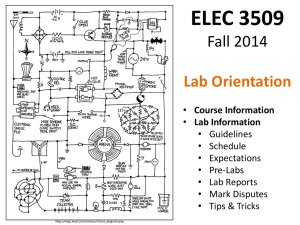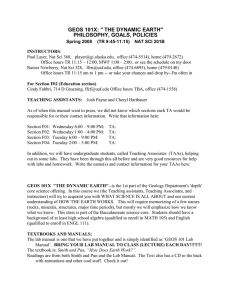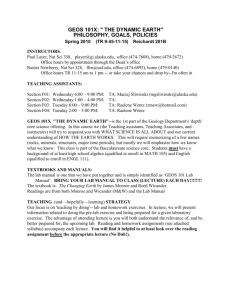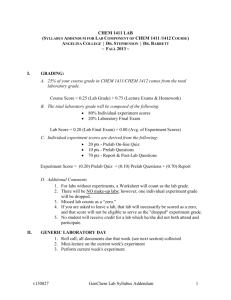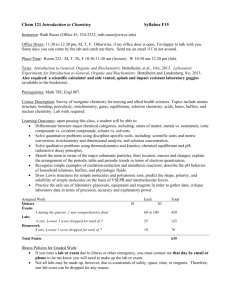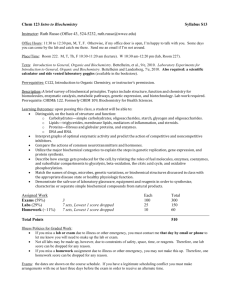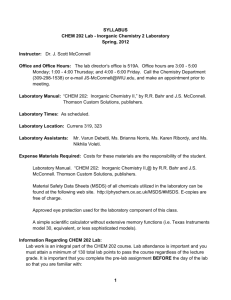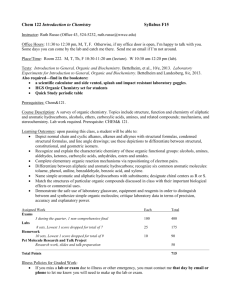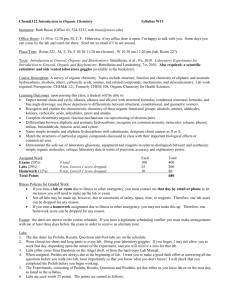ELEC 3509 Fall 2011
advertisement
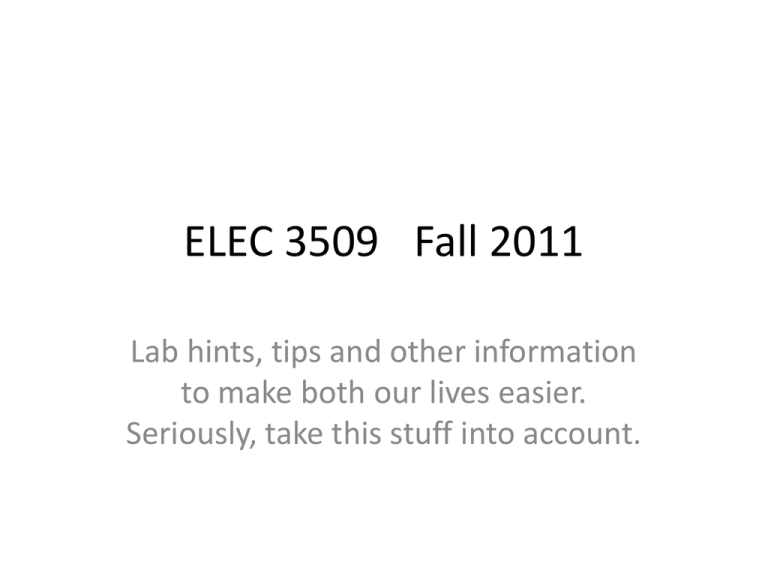
ELEC 3509 Fall 2011 Lab hints, tips and other information to make both our lives easier. Seriously, take this stuff into account. ELEC 3509 – Fall 2011 • Course website – http://www.doe.carleton.ca/~jrogers • Lab manual • Norman Fong (head TA) – 3081 Minto – nofong@doe.carleton.ca • Lab website – http://www.doe.carleton.ca/~nofong/ELEC3509 • Lab guidelines (read this!) • Lab marking schemes • Try to check this website at least once before each lab ELEC 3509 – Fall 2011 - Labs • Labs are worth 35% of your final mark • You MUST pass the lab in order to pass the course (even if you ace the midterm and final) • You MUST hand in a satisfactory report for every lab – You cannot hand in a blank sheet of paper and “take a zero” on a lab. • Lab kits will be sold during the first lab • Lab Plagiarism: Just don’t do it – Zero tolerance! Automatic zero for both parties. Lab Goals • Everything you do in the labs and prelabs is directly relevant to the course material and will be on the midterm and final exams. • Circuit building and design experience. • More importantly, this lab is designed to teach you to problem solve, work in a group and write proper lab reports. • As a 3rd year Engineering student you are expected to be able to debug your circuit on your own before calling over a TA. Lab Guidelines • Labs will be performed in groups of 2 • One report is to be submitted per group. Both students will be given the same mark. • Every lab will have a marked prelab. – All or nothing – Does not have to be 100% correct but reasonable effort must be shown • Every lab will have a marked checkout – Your lab must be complete on time and in your designated lab section • If you are knowingly going to miss a lab contact Norm prior to the lab – We can arrange an alternate lab day for you to attend without lateness penalty Lab Reports • • • • Reports are due one week after the lab has been completed They are due 30 minutes after the beginning of your lab session Drop off in stairwell drop boxes outside 41xxME. Late reports will lose 10% PER DAY. • If you are knowingly submitting your lab late, contact your TA immediately and an electronic submission may be accepted. • It is ultimately YOUR responsibility to have your lab in on time. Prelabs • Every lab has a marked prelab • The prelabs can be quite extensive. Don’t wait until the night before to start them! • You may be asked technical questions about your prelab to verify that it wasn’t just copied • The prelabs will be checked at the beginning of the lab (~first 30 mins) • The prelabs typically include all of your design calculations and hence you will not be able to start the lab until your prelab is done • You will likely not finish on time if your prelab is not ready at the start of the lab Lab Schedule November 18 19 20 21 Lab 1 Week 1 22 Lab 1 Week 1 23 24 30 31 26 27 28 Lab 1 Week 1 Lab 1 Week 2 29 Lab 1 Week 2 30 3 4 5 Lab 2 Week 1 9 10 12 Thanksgiving (no labs) 16 17 18 19 Lab 2 Week 2 23 24 Lab 2 Week 3 6 Lab 2 Week 1 11 26 7 20 8 University day (no labs) 13 14 Lab 2 Lab 2 Week 2 Week 1 Lab 2 Week 3 25 8 9 14 15 21 21 22 17 23 12 18 19 24 25 26 Lab 4 Week 2 December 27 28 29 30 1 Lab 5 22 11 Lab 4 Week 1 Lab 5 15 5 Lab 3 Week 2 Lab 4 Week 2 Lab 4 Week 2 Lab 2 Week 2 27 28 Lab 3 Lab 2 Week 1 Week 3 20 10 16 4 Lab 3 Week 1 Lab 4 Week 1 Lab 4 Week 1 October 2 7 13 3 Lab 3 Week 2 Lab 3 Week 2 1 Lab 1 Week 2 2 Lab 3 Week 1 6 25 1 4 2 3 Lab 5 5 6 7 8 9 10 13 14 15 16 17 Last day of Classes 29 11 12 Lab Tips • Familiarize yourself with the breadboard • • • • Utilize the upper and lower “rails” for your power supplies. Intelligently place your transistors, resistors and chips. Use short jumper cables instead of stretching out the pins on your device. Try to lay out your devices to match the circuit diagram. Lab Tips VCC=15 V Good idea Bad Idea Lab Tips + - Lab Tips • A potentiometer is a 3 terminal variable resistor which acts as a voltage divider. • You do not need to add another 1kΩ resistor to your circuit. The potentiometer is the resistor. Other Lab Tips • Do not measure current directly on the multimeter. • Measure the voltage across the resistor and use Ohm’s law (V = IR) • Use “Diode” range to measure diodes Lab Report Tips • The report should be “stand alone” – Readable without having prior knowledge of the lab – Clear as to what your goals were, what you did, what the results were – Results are explained and discussed – Do NOT just show your numbers • Reports should be thorough but concise – No strict format • Label all plots and figures with appropriate units • Stay in contact with your lab partner to make sure everything’s done on time.
